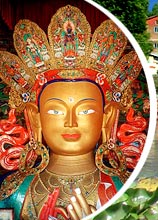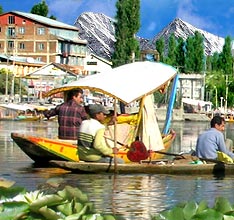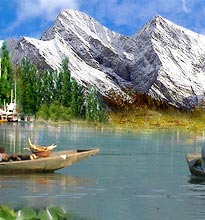Khanqah-e-Moula is situated in Srinagar, on the banks
of the river Jhelum. One of the oldest Muslim shrines in Kashmir, the
khanqah was built by Sultan Sikander built in 1395. The Khanqah is a
wooden structure whose chief aesthetic feature is its beautifully carved
eaves and hanging bells. The interiors are richly carved and painted,
and the antique chandeliers give it an air of opulence. The
Khanqah-i-Mualla is dedicated to Muslim preacher Mir Syed Ali Hamdani.
Also known as Shah Hamadan, the preacher came to Kashmir from the city
of Hamadan in Persia in the 13th century. He is believed to be
responsible for the spread of Islam in Kashmir. The Shah stayed in
Kashmir for many years and then left for Central Asia via Ladakh. He
also built a mosque at Shey (near Leh). The shrine gains a special
significance on 6th of Zilhaj (last month of Muslim calendar), the death
anniversary of Mir Syed Ali Hamadni. On this day, devotees visit the
shrine in large numbers to pay a tribute to Shah Hamadan.
The Khanqah of Shah Hamadan was the first mosque to be built in
Srinagar. The Shah used to meditate and offer his prayers daily on the
banks of river Jhelum, at the same spot where the shrine now stands. The
Khanqah of Shah Hamadan in Kashmir has undergone ruination a couple of
times. The year 1480 saw the shrine being ruined in a devastating fire.
Later, the shrine was reconstructed and restored by the then ruler
Sultan Hassan Shah. Again, in 1493 AD, Khanqah-e-Moula was demolished
and reconstructed in two-stories. A fire again struck the shrine in 1731
AD leading to first its destruction and then renovation by Abul Barkat
Khan.

    |




